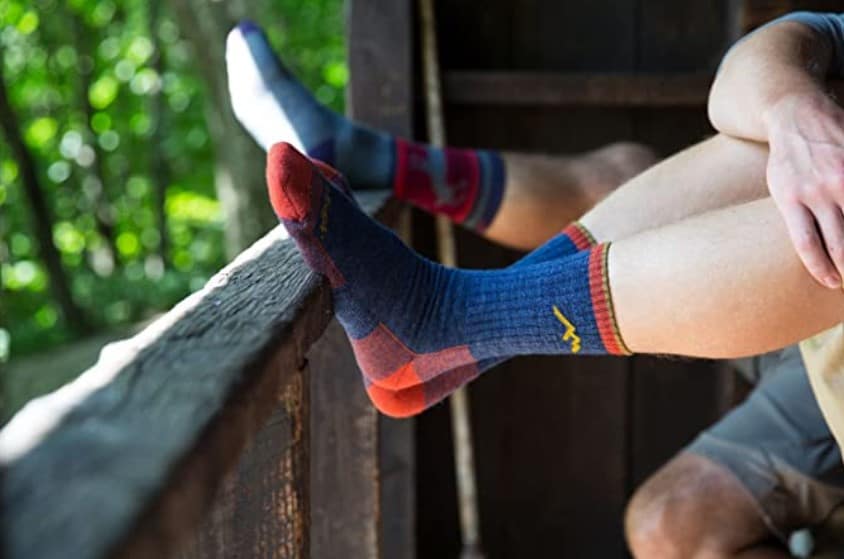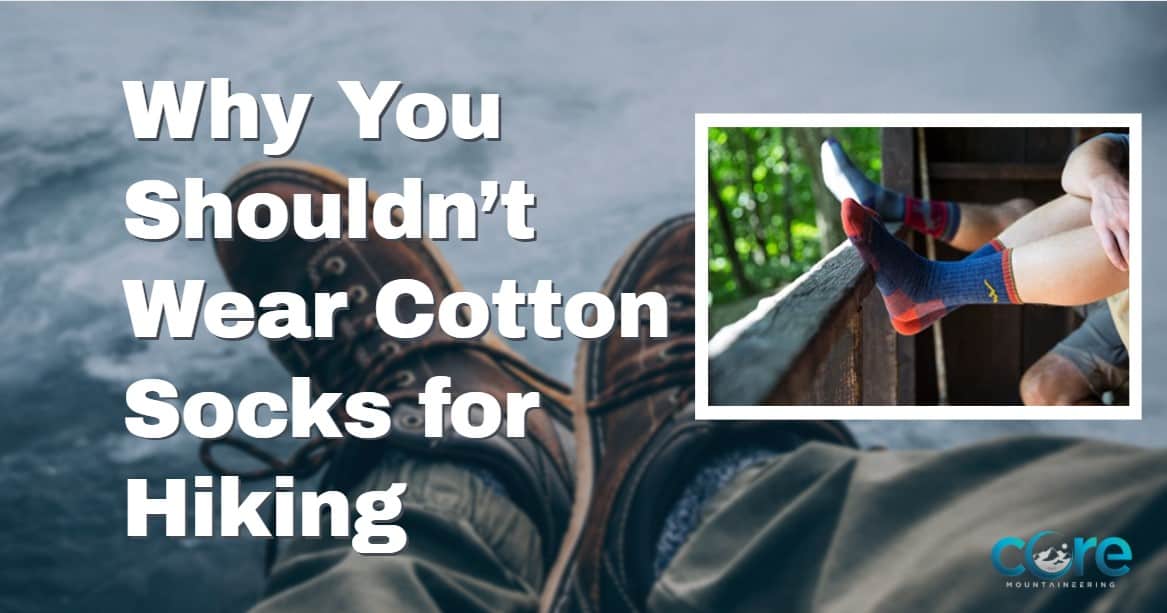When thinking about hiking clothing, socks usually don’t get enough attention. But they should. Your socks will determine your level of comfort when on your feet for hours.
Have you ever hiked while suffering through bunched-up, wet, sticky, or just plain uncomfortable socks? Not a fun experience. What you put on your feet should be your number one concern when hiking, and that not only includes the type of sock, but the type of fabric for the sock.
Generally speaking, cotton isn’t the best material to wear when hiking for an extended amount of time.
This includes your socks. Cotton is an organic material that absorbs moisture like a sponge, thus becoming heavy and uncomfortable. Once cotton gets wet, it no longer insulates your skin.
Now, you might think that your socks are safe inside your thick, waterproof hiking boots so it doesn’t matter. Well, technically that’s true for keeping away outside moisture, but it doesn’t help the biggest culprit: sweat.
Those thick, waterproof hiking boots are insulated, meaning your skin will generate lots of heat and that, in turn, generates moisture.
With so much moisture, you need to wear materials that dry quickly, cotton is not that material.
Below, I give reasons why cotton socks wreck your hiking experience, other fabrics to avoid, and give some better options.
If you’re having a problem with blisters on the trail or you’re looking for the best socks for hiking, check out our article, Do Hiking Sock Liners Prevent Blisters? What Hikers Really Use.
Yes, Cotton Socks Are a Poor Choice for Hiking

Even if you’re just hiking for a few hours, you want to be comfortable. When your feet are uncomfortable, then your entire hiking experience is uncomfortable.
Here’s how cotton socks make hiking a miserable experience:
- Cotton is a heavy fabric, to begin with, and gets even heavier when wet.
- Cotton soaks up sweat and stays wet, thus keeping your feet wet.
- When cotton is wet, it no longer insulates your skin to keep you warm.
- Cotton takes a long time to dry, meaning you’ll stay wet for longer periods of time.
Wearing layers of cotton won’t save you, either. Because the fabric absorbs so much moisture, instead of having one layer of wet socks, you’ll have two.
The worst that can happen when wearing wet, heavy cotton socks is you’ll get blisters. And as anyone who has hiked knows, blisters on your feet are your biggest enemy.
Cotton Socks Are Not the Only No-No
There are other fabrics that absorb water like cotton, thus making them a poor choice for hiking socks. Avoid these materials when searching for socks:
- Cellulose: This type of fabric is often labeled as rayon, modal, and viscose. When wet, materials made with cellulose have zero insulation, which means your wet feet will get cold and stay cold.
- Silk: Although silk has moisture-wicking capabilities, it’s not a durable material for socks as it will wear out rather easily and not keep its shape. Instead, silk is best used as a secondary material, like a sock liner.
- Denim & Flannel: Don’t let these popular and well-known names fool you, they’re still cotton-based. Fancy socks with these materials should be avoided.
What Is the Best Sock to Wear for Hiking?
So now that we’ve rejected cotton, we need to find a wicking fabric for your socks.
Wicking fabrics will move water away from your skin to the outer layers of the fabric, thus keeping you dry.
Below are some good options for socks with wicking action:
Hiking Socks Synthetics
Think polyester, spandex, and nylon. These materials will provide comfort, keep you warm, keep their shape, and dry fast. Popular synthetic blend socks you can find on Amazon include Injinji Hiking Socks and Darn Tough Hiker Micro. Some things to know:
- Polyester is a good insulating material usually blended with wool and nylon for superior wicking properties.
- Spandex is extremely elastic and when used in socks, helps keep their shape so they won’t wrinkle or bunch up.
- Nylon is an extremely durable material and is usually the primary component of a synthetic blend.

Cocona Hiking Socks
Cocona fabric is made from coconut shells and is known for its fast-drying ability and incredible durability—you can wash these socks hundreds of times without losing shape or wearing them out.
Best of all, this material is all-natural and eco-friendly.
Merion Wool Hiking Socks
If you want another natural fabric to replace cotton, consider merino wool. Although it doesn’t have amazing wicking capabilities, wool will keep you insulated even if wet. And, wool dries out incredibly fast.

Your best bet is to find socks that have merino wool blended with other synthetics to create a moisture-wicking sock that is also insulating.
Check out Darn Tough’s merino wool hiking socks on Amazon here. People Socks merino wool hiking socks are another popular option, especially for hiking in cold weather, also available on Amazon here.

Do I Have to Give Up Cotton Hiking Socks Completely
Not necessarily. You can still have some cotton in your sock. There are new fabric blends that fuse cotton with other synthetic fibers to reduce water absorption and increase drying time. Check out:
- Under Armor charged cotton: This sock is 26% cotton, 71% polyester, and 3% spandex. The sock promises to wick away moisture and is considered breathable, meaning it won’t trap heat and moisture. You can buy packs on Amazon.
- Dri-release cotton: This is a fabric blend of 15% cotton and 85% polyester that claims to dry 4x faster than cotton and remove perspiration from your skin. There are many different brands that use this fabric, but Gamma sells theirs on Amazon.
- Nike Dri-Fit cotton: Nike has their dri-fit series that is 76% cotton with additional blends of nylon, spandex, and polyester. While this is a higher cotton content, they claim their cotton is moisture-wicking.
Wrapping Up Cotton Hiking Socks
Cotton is usually what we think about when thinking of sock materials, but it shouldn’t be your go-to fabric for hiking socks. Whether you are in warm weather or cold, you need a sock that can sweep away sweat from your skin so that you don’t walk around with wet feet.
You want socks that keep you dry, and keep you warm and cool! So save the cotton for your everyday use. When hiking, look toward wool and synthetic blends. Happy hiking!








For last two years been hiking with Merino wool socks- yesterday went for an 8 mile hike and for reasons unknown I grabbed cotton socks- blisters on both feet ! Won’t make that mistake again anytime soon!
I know what you mean. I use to get gnarly blisters when I hiked in regular cotton socks.